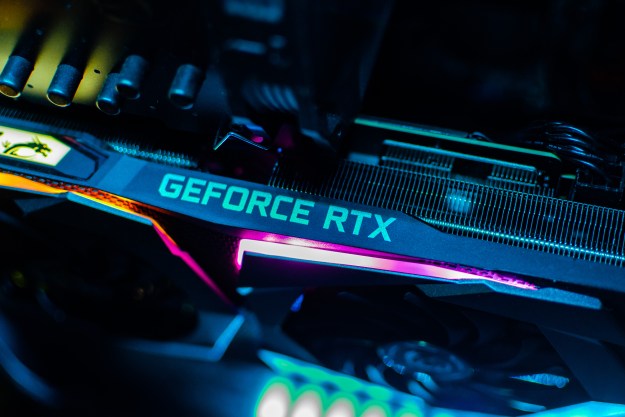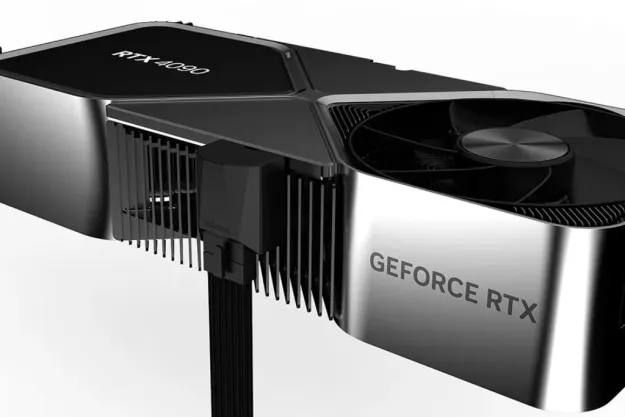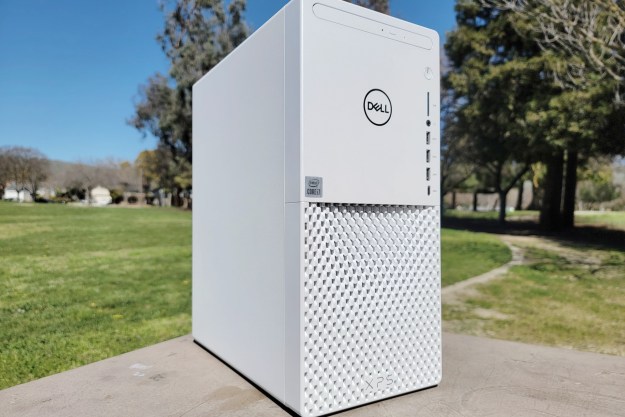
“Dell’s midrange GPU still delivers more than 80% of the performance of the flagship GeForce RTX 3080 graphics card while saving shoppers a fair amount of money.”
- Chic aesthetic
- Nice balance of performance and price
- 4K gaming in compact design
- Easy way to get an RTX 3070 despite GPU shortage
- No Ryzen configurations
- Limited expandability
If you need a work-from-home desktop, you’ve probably considered the Dell XPS Desktop at some point. It’s not for hardcore gamers, nor is it as boring as a standard office tower. But don’t forget that this is XPS, a premium brand with a high reputation in the laptop space. So, the question is does the XPS Desktop also nail that same balance of excellent design and impressive power?
To find out, I took a look at the latest iteration, the XPS 8940 SE Desktop, which is the white version of the standard black model. Prices start as low as $649, but my upgraded configuration skyrocketed up to $2,136 due to the inclusion of the Intel Core i7-10700K, Nvidia RTX 3070, and 32GB of RAM.
GPU supply issues aside, Dell provides plenty of upgrade options to deliver a system that’s as powerful as you need, making the XPS Desktop a versatile champ for the home, dorm rooms, and even gaming and moderate creative tasks when it has top-of-the-line specifications.
Video review
Design
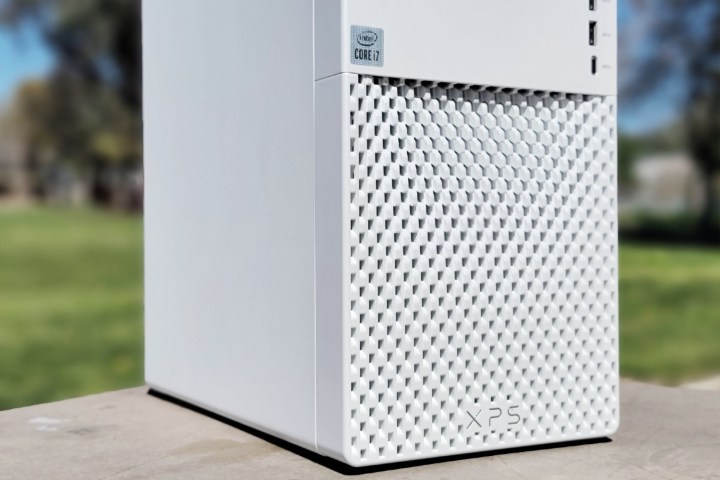
The XPS 8940 comes in either an understated Night Sky black trim or the chic Mineral White hue found on our Special Edition configuration. It’s a new look for the line, and it’s definitely an improvement overall. It’s a simplified and modernized design, so as long as you know what you’re getting into. Compared to Dell’s Alienware Aurora gaming desktop, the XPS foregoes the distinct sweeping curves and bold contours found on its more premium sibling in favor of a traditional, and decidedly boxier, design.
Though the sharp lines and angular design of the XPS Desktop might conjure boring images of a corporate desktop, it looks less conservative than it seems in the Mineral White color. The top half of the front is encased in a slightly curved, smooth plastic panel that houses the optional optical drive — a rarity even for desktops in this day — along with a power button and vertically aligned ports, one of which is a USB-C port for a bit of future-proofing.
Just below the curved plate, a flat and slightly recessed perforated grill comprises the lower half of the front panel of the XPS Desktop. This lower panel not only adds a bit of texture to an otherwise muted design, but also adds a bit of visual interest, and the white Special Edition shade elevates the whole aesthetic of the desktop. The perforated panel can resemble a car panel, giving the desktop a modern and contemporary appearance in a minimalist setup, but it can also feel equally at home in a summer cottage, as the lattice can also be seen as a modern reinterpretation of cane or rattan furniture in this environment. I do wish the plastic panel on the front was a bit higher quality, though, as it feels hollow and light when you touch it.

The sides of the XPS Desktop are made of color-matched metal plates that join together at the top with an off-centered seam. The left panel can be easily removed with a couple thumbscrews on the back side, making upgrades and repairs relatively easy. The solid metal sides — rather than a see-through tempered glass side window — helps keep the XPS Desktop’s design conservative enough for use in a more professional office setting, as you won’t find any attention-grabbing RGB lighting emanating from inside the tower.
And without the distraction of see-through panels, Dell was able to focus its engineering efforts on function rather than form. Cable management is still tidy despite the lack of a windowed design, but the inside’s layout is rather sparse without many details or RGB lighting. The bright side is that Dell did a great job with cooling and airflow. Even though the XPS isn’t as whisper-quiet as a fanless laptop — like Apple’s MacBook Air — fan noise is very low and not distracting. Dell’s desktop has a single fan in the case and two fans to cool the GPU. The CPU, meanwhile, uses a twin-tower-style air cooler. It’s not the prettiest thing in the world, but it gets the job done.
Ports and connectivity

I appreciated that ports are divided between the front and the rear, which helps with both ease of access and cable management.
On the front, you’ll find a full-size memory card reader, a headset jack, and four USB 3.2 Gen 1 ports that include three Type-A ports and a sole Type-C port. It’s nice that Dell included a Type-C port in the front to quickly connect or charge modern smartphones. The optical drive can also write to Blu-ray discs.
On the rear, you’ll find four more USB 3.2 Gen 1 ports, all of the Type-A variety, along with two additional USB 2.0 ports. There’s a Gigabit Ethernet jack, as well as jacks for the headphone, microphone, and audio line out.
The motherboard has its own HDMI and DisplayPort, but since the desktop ships with its own GeForce RTX 3070 GPU, you’ll want to use either the line HDMI or three DisplayPort video outputs to connect an external display.
Upgradability
Dell’s use of proprietary components may limit this rig’s appeal among enthusiasts. The tower’s compact 19-liter size also means that Dell went with a custom motherboard, so upgrades (aside from the RAM and storage) could be more difficult down the road as the system ages.
If you’re a data hoarder, though, the good news is that there are two empty 2.5-inch drive bays for adding more storage. Installing some more storage should be fairly easy, even for a PC beginner.
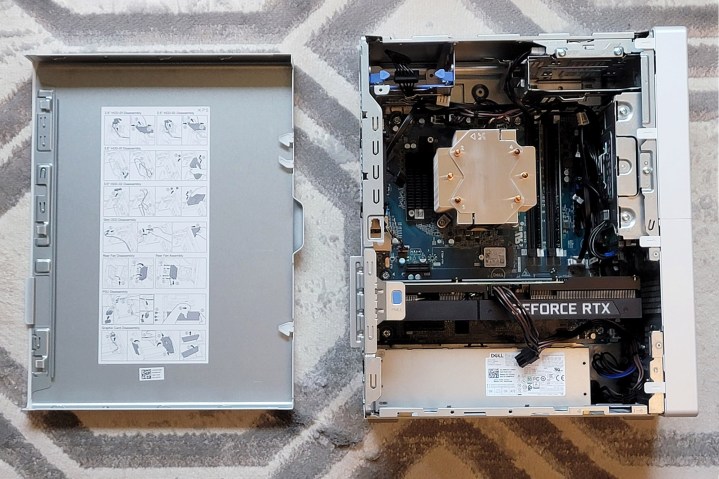
Despite the small size, Dell was able to squeeze a full-length GPU in our review unit. The graphics card occupies both the PCIe x16 slot and the expansion slot for dual-width graphics cards — but upgrading to anything beyond an RTX 3070 may be futile. The desktop can also accommodate additional PCIe x1 and PCIe x4 cards.
There are a couple limitations with this desktop. The first is that although the 500-watt PSU is sufficient for this class of graphics, upgrading the PSU for more powerful graphics will be challenging. DIYers will be limited by the available space for the PSU at the bottom of the case. But the bigger problem is Dell’s use of a proprietary 6-pin connector for power on the motherboard. This means that if you want more powerful graphics, you’ll need to resort to an external PSU and have to snake cables to the inside of the case as an inelegant workaround.
Speaking of the power supply, the 500-watt unit included isn’t technically up to spec for what Nvidia requires for the RTX 3070, which is 650 watts. I haven’t noticed a drop in performance as a result, but you are wading into uncertain waters outside the recommendations of Nvidia. For a prebuilt desktop, that’s a bit strange.
Cables inside are neatly arranged — wires generally snake across the top, down the front, and flow toward the bottom, where the PSU is located. Cables are bundled together with a few tie wraps, but you won’t find elegant cable management systems like on more premium boutique builds. It’s not a complete mess, which is good.
Performance
Our Special Edition XPS Desktop, priced at $2,136 as configured, shipped with a 10th Gen Intel Core i7-10700K processor, though Dell didn’t overclock the CPU out of the box, paired with a midrange Nvidia GeForce RTX 3070 GPU and 32GB of memory. Given that the XPS line tops out with an RTX 3070, shoppers looking for anything higher — like an RTX 3080 or RTX 3090 — will have to step up to the more premium Alienware Aurora Desktop in Dell’s lineup.
Though Dell recently introduced a small performance refresh to its XPS Desktop by offering 11th Gen Intel Core configurations, AMD gamers will also need to look elsewhere. Notably, Dell’s lineup is devoid of builds with Ryzen processors, though some limited configurations ship with Radeon graphics. While I wish there were more diverse builds, the performance I got from the 10th Gen K-series processor on our Special Edition review unit is more than capable for most gaming, creativity, and productivity tasks, and even gamers will be pleased with the agility of this desktop with some upgrades.
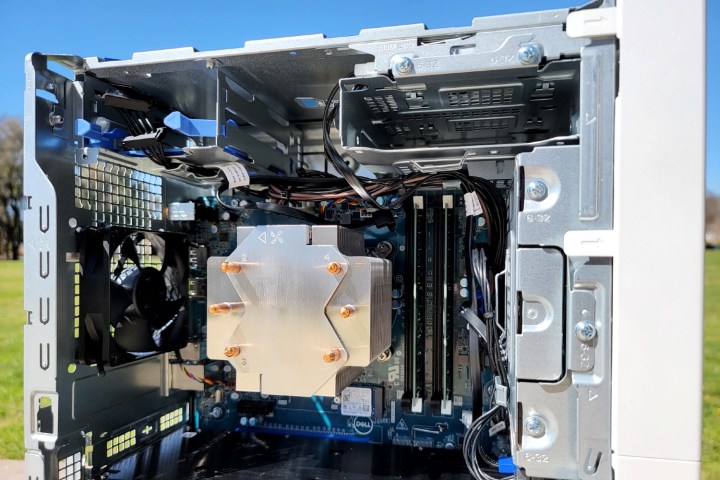
The XPS scored just over 7,300 points on our PCMark 10 test, which is in line with what you can expect from Intel’s Core i7-10700K. Performance of the XPS Desktop is lower than a system with a Core i9-10900K configuration, as expected, but higher than a rig equipped with AMD’s Ryzen 9 3950X, like Alienware’s Ryzen-powered Aurora R10 AMD Edition.
The Core i7 is more than capable of handling most tasks I threw at it, and Dell’s K-series variant delivers strong performance at a more affordable price. Similar to PCMark 10, the Core i7-10700K achieved a single-core score of 1,355 points and a multi-core score of 9,034 points. These scores mean that the i7 trailed the Core i9-10900K and the i9-10900KF processors, but by a very negligible amount.
In the synthetic Geekbench 5 benchmark, the XPS Desktop’s score shows that Intel’s 10th Gen processor still can hold its ground in multi-core performance, even when compared to Apple’s new M1 processor on the Mac Mini desktop. The Mac Mini’s single-core score of 1,707 points blows past the XPS Desktop, but Apple’s desktop trailed Dell’s offering by close to 1,700 points in the multi-core test.
The XPS Desktop achieved competitive single- and multi-core results compared to other Intel processors on the Cinebench R23 test, earning 1,311 and 13,586 points, respectively. Like with the Geekbench 5 results, this means that the M1-powered Mac Mini performed better on the Cinebench R23’s single-core result, but Intel holds on to its multi-core performance — for now — with a margin of 42% compared to the M1 processor.
In day-to-day tasks, the system can handle multiple browsers with multiple tabs opened, Microsoft Office applications, and creative software like Adobe Creative Suite without any noticeable delays or lags. Some more demanding games launched a tiny bit faster on the better Core i9 processors, but that’s only noticeable if you have both systems side by side to compare.
The XPS Desktop ships with dual drives, a strategy that allows Dell to deliver the most amount of storage at a more cost-efficient price, with room to accommodate additional drives. Inside, you’ll find a primary 512GB NVMe solid-state drive that’s attached to the sole M.2 slot on the motherboard, alongside a 3.5-inch 2TB hard drive. Speeds were zippy with the solid-state drive, and you’ll want to place your apps and games that you need most on the 512GB drive, reserving the more spacious 2TB to store less frequently used digital files.
Performance of the Core i7-10700K in our Blender test shows that it trails the more powerful Intel Core i9-10900K, as well as AMD’s Ryzen 9 3900X and Ryzen 9 5900X CPUs, in the BMW benchmark. In fact, the Core i7-10700K’s rendering performance is similar to AMD’s Ryzen 7 3800X and the Ryzen 7 3800XT.
In the Classroom benchmark, the Core i7-10700K’s performance is very similar to the Core i9-9900K, though rendering time took slightly longer than AMD’s Ryzen 7 2800 X and XT series. Stepping up to a 10th Gen Intel Core i9 would help decrease rendering time even more.
Graphics performance
Despite a build that tops out with just an Nvidia GeForce RTX 3070 GPU, the XPS Desktop is no slouch. The RTX 3070 can handle the majority of 4K games you throw at it. Most gamers will do fine choosing this card, as it can easily handle modern titles. Dell outfitted our review unit with a 500-watt power supply unit that’s powerful enough to handle this GPU configuration, but tinkerers looking to upgrade to a more powerful graphics will be limited by the PSU’s rating.
In our 3D Mark benchmark, the XPS Desktop’s Fire Strike score of 25,213 points and Time Spy score of 12,489 points place the RTX 3070’s graphics capabilities ahead of the prior generation RTX 2080 and within striking distance of the more premium GeForce RTX 2080 Ti. This is quite the feat given the RTX 3070’s midrange position in Nvidia’s RTX 3000 series lineup. For comparison, the RTX 2080 scored just above 11,500 points in the Time Spy Test, while the RTX 2080 Ti scored in the mid-13,000s.
The RTX 3070’s performance in creative tasks is similar to its graphics performance. In our PugetBench Premiere Pro benchmark, the XPS Desktop’s score of 689 again places it behind the performance of the RTX 2080 Ti and ahead of the RTX 2080. Compared to the near-800 mark earned by the 3070, performance is approximately 85% of its more expensive sibling. This card should be able to handle photo- and video-editing tasks with ease for most home users.
This card should be able to handle photo- and video-editing tasks with ease.
Given its more affordable price in Nvidia’s lineup compared to the more premium RTX 3080, it’s hard to find fault with Dell’s decision to go with the RTX 3070 given that this card can still achieve frame rates in excess of 100 frames per second (fps) in 4K. The strong performance of the RTX 3070 is enough reason for enthusiast gamers to upgrade to the latest GeForce generation if they’re coming from an older GPU.
In fast-paced games like Epic’s Fortnite, he RTX 3070 performed at 120 fps in Ultra game settings, though scaling down to High game settings will boost the frame rate to a whopping 187 fps, a jump of 55%. In 4K, the frame rate drops to just 63 fps in Ultra and 110 fps in High settings.

This compares quite favorably to the 78-fps performance of the RTX 3080 in Ultra at 4K and the roughly 55 fps performance of the RTX 2080 Ti. Here, the performance of the RTX 3070 is approximately 81% of the RTX 3080, and this year’s midrange card outperformed the prior generation’s 2080 Ti by 8 fps.
In more graphics-intensive titles, like Assassin’s Creed Valhalla, the RTX 3070 struggled a bit more due to the GPU’s more limited hardware capabilities and the fact that this card ships with just 8GB of GDDR6 RAM compared to the 10GB of GDDR6X memory on the flagship RTX 3080. This game played at 74 fps in 1440p and just 48 fps in 4K with the RTX 3070 with the game’s quality set to Ultra. On a system equipped with an RTX 3080, the game never dipped below 60 fps in Ultra settings at 4K. Gamers who play titles with more challenging graphics rendering will want to stay at 2K 1440p or UWQHD resolution.
The RTX 3070 manages to handle Battlefield V, which is a demanding title, with relative ease, punching above 80 fps in Ultra settings at 4K. Performance jumps to 140 fps if you scale down to 1440p resolution. With Battlefield V, Nvidia’s newest midrange offering outperforms the prior-generation flagship, as the RTX 2080 Ti only managed to squeeze 76 fps in 4K, while this year’s RTX 3080 performed at 97 fps.
In Civilization VI in Ultra settings, the game consistently clocked higher than 100 fps in 4K. If you’re a gamer playing less-demanding titles, even the RTX 3070’s graphics capabilities may be overkill.
Our take
The Dell XPS 8940 Desktop strikes a nice balance of power, performance, and price packed into a chic and compact tower. In a sea of boring, office-oriented PC towers, the XPS has just enough design finesse to make it stand out. It’s an excellent work PC and, with the right configuration, is even a capable gaming machine. If you want a desktop you won’t have to mess with much, the XPS 8940 is the best option you can buy.
Are there any alternatives
Though it isn’t billed as a gaming rig, the XPS Desktop is versatile enough to compete both against other creative workstations and gaming-forward PCs. Competitors include the capable Lenovo IdeaCentre 5i , which like the Dell, starts at an affordable $499. Unlike the XPS, however, the IdeaCentre isn’t as suited for gaming, as it lacks the option for a discrete GPU. As such, the Lenovo desktop is more aptly equipped for office tasks, web browsing, and light gaming. Creatives who need more graphics power will likely want to turn to the company’s Legion desktop lineup.
HP’s Omen 25L is another great competitor to the XPS Desktop. Sporting a more compact footprint than the larger Omen 30L, the Omen 25L boasts a more gaming-forward windowed design, RGB backlighting, and more diverse configuration options. The smaller Omen tops out at just an RTX 2000 GPU, so if you need more modern 3000 series graphics, You’ll have to upgrade to the Omen 30L. At $1,999, HP’s similarly configured system with a slightly better Core i9 processor in a larger size runs a bit cheaper than our review unit.
How long will it last?
Given the power and performance of the XPS Desktop, this rig will deliver years of work productivity and gaming pleasure. The ability to upgrade major components, like the motherboard and GPU, is more limited due to Dell’s use of proprietary components, so be sure to select the build you want at the time of purchase. WYSIWYG (What You See Is What You Get) applies in terms of ability to upgrade this system.
Dell includes a basic one-year standard warranty with the option to upgrade to longer coverage packages, the ability to add accidental damage, and at-home repairs with its Premium Support and Premium Support Plus package. Extended coverage starts at $179 for two years of service, though a four-year plan with accidental damage coverage and automated virus removal costs $679.
Though premium coverage may seem like a decadent addition for a desktop that is less prone to damage than a laptop, those working from home in the midst of the global health pandemic may find value in turning to Dell’s technicians for a bit of IT support.
Should you buy it?
Yes. It’s not for die-hard PC enthusiasts, but it’s a fantastic desktop tower for the average shopper.
Editors' Recommendations
- All ray tracing games on PC: AMD Radeon and Nvidia RTX ray tracing
- AMD might crush Nvidia with its laptop GPUs — but it’s silent on the desktop front
- Microsoft’s Surface Laptop Studio 2 might get a massive performance boost
- We now know the eye-watering price of Nvidia’s RTX 4090 gaming laptops
- What power supply do you need for the AMD Radeon RX 7900 XTX?


